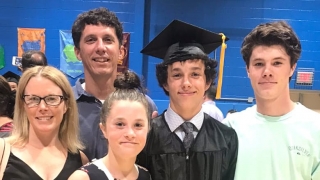Coronary Artery Anomaly: Ryan's Story
Published on
Published on
Last summer, over the course of just a few weeks, 13-year-old Ryan went from active middle school athlete to open-heart surgery patient. It’s a story no one saw coming.
 Ryan with his family at 8th grade graduation
Sports are everything to Ryan. In the summer of 2018, he did what many of peers did: He participated in conditioning camp for football. But one day, during the drills, he felt a crushing pain in his chest and almost passed out. He felt like everything was going black, and began to lose feeling in his arms and legs. He almost fainted, but got up and rejoined the practice.
Ryan with his family at 8th grade graduation
Sports are everything to Ryan. In the summer of 2018, he did what many of peers did: He participated in conditioning camp for football. But one day, during the drills, he felt a crushing pain in his chest and almost passed out. He felt like everything was going black, and began to lose feeling in his arms and legs. He almost fainted, but got up and rejoined the practice.
His coach called Ryan’s parents, Luke and Colleen, telling them, “You should pick up Ryan. He’s not feeling well,” Colleen remembers.
That night, Ryan told his parents how scary the experience had been. “He said he felt like he was dying and it scared him,” Colleen says. She knew it was time for him to see a doctor.
Ryan's pediatrician initially suspected he'd just been dehydrated, but because of his father's family history of heart issues, the pediatrician recommended Ryan see a cardiologist to rule out any serious cardiac issues.
Colleen and Luke brought Ryan to Children’s Hospital of Philadelphia (CHOP), where doctors suspected Ryan had a coronary artery anomaly. A cardiac MRI confirmed Ryan had anomalous left coronary artery from the right sinus of Valsalva with a course between the aorta and pulmonary artery, also known as interarterial AAOLCA. In patients with AAOLCA, the left coronary artery arises from the wrong aortic sinus, and this places young athletes at risk for sudden cardiac arrest and death, notably with exercise.
Because Ryan was at increased risk, he was immediately restricted from all sports. “For once, I couldn’t do anything,” Ryan said. “I didn’t like being confined, but I knew I had no choice.”
At a follow-up appointment, CHOP cardiothoracic surgeon Christopher E. Mascio, MD, told the family that Ryan would need open-heart surgery to fix the anomaly. A few days later, Ryan was wheeled into an operating room in CHOP’s Cardiac Operative and Imaging Complex.
The operation was complicated, and Ryan was restricted to bed rest for four days following the operation. Though scared for Ryan, Luke and Colleen say they were extremely pleased with the care and support they received from everyone at CHOP. Luke says:
“I don't think we would have felt comfortable anywhere else.”
Following surgery, Ryan had to miss several weeks of school, and was closely monitored by his medical team. Once he returned to school, he needed help for a while. Thankfully, his friends were a great support, helping to carry his books and navigate the hallways, Ryan says.
Eight months after surgery, Ryan's doctors finally cleared him to return to play one sport — the one he loves most — lacrosse. After nine months with no physical activity, Ryan returned to the lacrosse field where he was a key part of the defense, helping lead the team to an undefeated season.
Ryan’s experience made his parents realize how important it is for everyone — even kids — to listen to their own bodies. Only later did Ryan reveal to his family that football camp wasn't the first time he'd experienced cardiac symptoms. Instead of stopping or asking anyone for help, Ryan continued to push himself.
“Coaches and kids need to know not to push through the pain if they're not feeling right,” says Luke. “Thankfully, Ryan's coach called us or we may not have had the discussion with Ryan about how he was feeling."
As Ryan heads into his freshman year of high school, his future looks bright. He's back to the active lifestyle he craves and finally feels like himself again. Life is back to normal in Ryan's household.
"Before and right after his surgery, we watched his every move," Luke says about Ryan. "Now, he can pretty much do whatever he wants."
Ryan will need long-term monitoring for his cardiac condition, and is scheduled to return for appointments with cardiologist Julie Brothers, MD, FAAP, who is Medical Director of the Coronary Anomaly Management Program. Ryan's only ongoing treatment is to take a baby aspirin daily to avoid potential blood clots related to his condition, and that an automated external defibrillator (AED) is present during any athletic activity he participates in.
“If it wasn’t for them being as good as they are, I wouldn’t be here today,” Ryan says of the Cardiac Center team at CHOP. He credits them for saving his life and preserving his quality of life.
“I’m so glad I can get out on the field and play again. It’s everything to me. ”